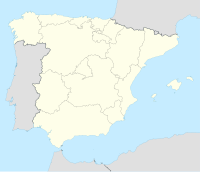Badajoz Alcazaba
| Alcazaba of Badajoz | |
|---|---|
| Alcazaba de Badajoz | |
| Badajoz, Spain | |

The Alcazaba of Badajoz by night.
|
|
| Coordinates | 38°52′58″N 6°58′06″W / 38.8828°N 6.9683°W |
| Type | Fortress |
| Site information | |
| Open to the public |
yes |
| Condition | Partially restored |
| Site history | |
| Built | 9th century |
| Built by | Almohads |
The Alcazaba of Badajoz is an ancient Moorish citadel in Badajoz, Extremadura, western Spain. The alcazaba as it now appears was built by the Almohads in the 12th century, although it probably existed from the 9th century, when Badajoz was founded. In the 11th and 12th centuries it was the residence of the rulers of the taifa of Badajoz.
It was declared a national monument of Spain in 1931.
Badajoz was founded by Abd-al Rahman Ibn Marwan in 875. After he had led several rebellions, he was expelled by Mérida but was given the chance to found a new city. Here, on a hill commanding the new city, he built a large citadel which granted Badajoz a strategic role in controlling the passage from Portugal to central Iberia.
The current line of walls date mostly from the Almohad age, although there are traces of earlier work from 913 and 1030; in 1169 the Almohad caliph Abu Yaqub Yusuf rebuilt the fortress, giving it its current appearance. The last Muslim restoration was carried on by Abu Yahya ibn Abi Sinan in the 13th century, few years before the capture of the city by the Christian King Alfonso IX of Castile.
The citadel measures 400 by 200 metres (1,310 ft × 660 ft). It is bounded to the north by the Guadiana river and to the east by the Rivillas torrent. The less steep parts of the slopes and other strategically weak points are defended by towers. The whole line of walls features a parapet, while the barbican and the ditch which once added protection have disappeared.
In the towers area was the palace of the lords of Badajoz, featuring several baths and mosques. After the Christian conquest, the largest, the Great Mosque, was turned into a church, Santa María de Calatrava, which acted as the cathedral of Badajoz until the construction of the current one. The Great Mosque had five naves separated by arches supported by columns, and external buttresses. For its construction elements of Roman and Visigoth edifices were used, such as capitals and columns. Another building of the Muslim palace which was converted after the Christian conquest was the Military Hospital, now home to the Library of Extremadura.
...
Wikipedia

